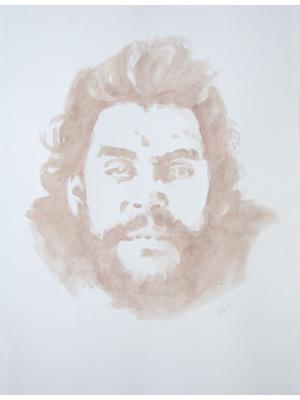Jose' Toirac
dal 9/7/2003 al 18/10/2003
Segnalato da
9/7/2003
Jose' Toirac
Gallery 106, Austin
Sacrifice. All the works in this exhibition have in common the fact that they have been made with red wine. Wine is a material that possesses the opposites of nature and culture. To make wine, it is necessary to cut, squash and ferment grapes. The death of the grape is also a process in which the fruit becomes a drink. For this reason, wine is a symbol that incorporates life and death, as well as the means to overcome them.

Sacrifice
Artist's Statement
All the works in this exhibition have in common the fact that they have been made with red wine. Wine is a material that possesses the opposites of nature and culture. To make wine, it is necessary to cut, squash and ferment grapes. The death of the grape is also a process in which the fruit becomes a drink. For this reason, wine is a symbol that incorporates life and death, as well as the means to overcome them. As with bread, wine is one of the substances of transubstantiation.
In 1996, I used for the first time in my work the analogy between wine and blood in my first version of Ephemerides (1996). This work is composed of 149 portraits made with red wine on paper, of the heroes that died in the previous days and during the landing for Bay of Pigs in April of 1961.
From middle of the 1990s until the present time I have produced several works with red wine. Two of these works are showing here: The Holy Sheet (2000) and Prophecies (2000). Both were exhibited previously in the Lisa Sette Gallery in Arizona (2000) and GalerÃa Habana, in Havana (2001). The Holy Sheet is an allusion to the Shroud of Turin. It is a drawing with red wine on a white sheet of Che Guevara's (1) dead body based on a photograph taken by the Bolivian photographer Freddy Alborta. Prophecies is also made with red wine. It composed of thirteen works on paper, which include fragments of Che Guevara's farewell letters to Fidel as well as his parents and children in 1965.
This exhibition includes a series of drawings and projects of installations shown previously, such as Sacrifice (2003) at the Art Gallery of Havana University and Ephemerides (1999), acquired by the Museum of Modern Art, New York in December 2000 and exhibited there from October 2001 to January 2002.
Although all the works are inspired by facts very specific to the history of Cuba (and being a Cuban artist it is something natural), the use that I make of the red wine gives them a more universal and symbolic meaning.
Sacrifice (2003) is gives its title to the exhibition at Gallery 106 and is exemplary of this interest in exploring universal themes. The work is based on a photograph of a Bolivian soldier pointing at the bullet hole in the side of Che Guevara's dead body. This picture is the starting point, but my work doesn't refer to a concrete historical figure. Sacrifice is an orifice from which flows a continuous stream of red wine in allusion to any number of classic, mythical, and universal heroes that offered their lives in sacrifice to affirm a moral order beyond their own experience. The heroes are to such a degree the highest point of the human landscape, who seem the inevitable conductors of the force around them, great trees more vulnerable to lightning than a blade of grass. The courage with which the hero confronts his destiny is as tragic and significant as the passion and death of the Son of God. In true tragedy, there is no possible success; the prophecies fulfill themselves with a divine rigor. All the direction of the drama consists in showing the logical system that will consummate in the misfortune of the protagonist. As spectators, we observe the fatal progress of a hero whose persistence condemns him to the debacle, but by which we do not wish to see him defeated. His death is a sacrifice. His sacrifice is an appeasement or act of thanks; a payment or a petition, but always must have something or someone on the other side. Call this "other" God or History, these are nothing more than terms, names created in order to attempt to describe the dreams of all those who, at one time, struggled for human happiness.
José Toirac
Havana, May 28, 2003
Gallery hours are Tuesday through Saturday, 10:00 a.m. to 5:00 p.m.
Gallery 106
2832 East Martin Luther King Blvd.
Austin, Texas.
Tel. 512-472-1219



